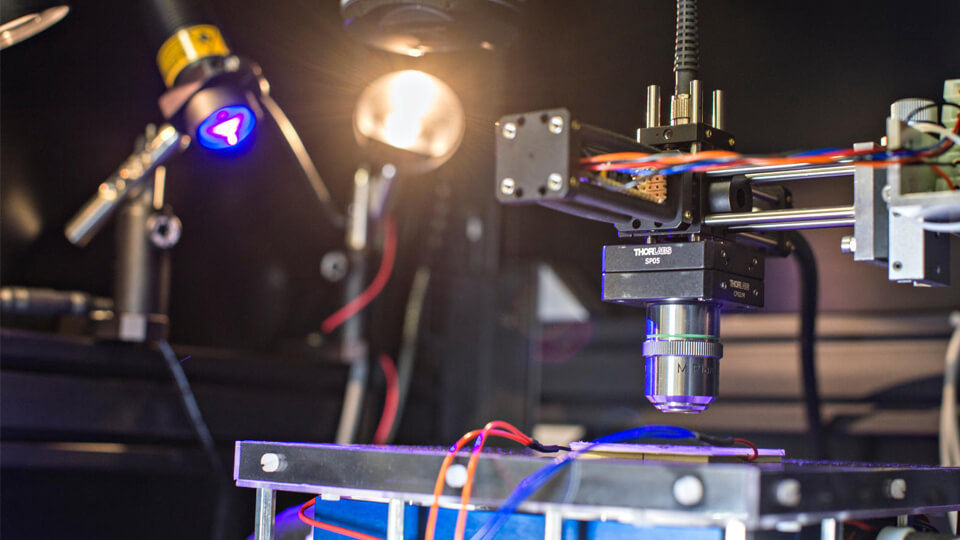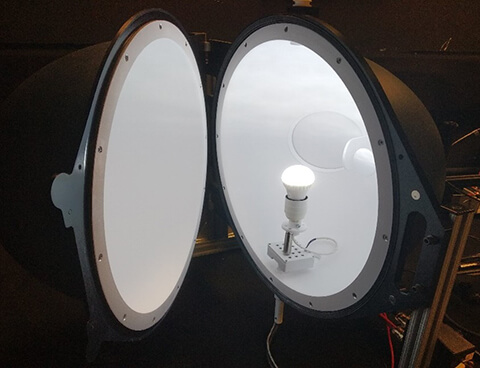Renewable Energy for Development - Our Facilities

CREST has established laboratory facilities to research, develop, design and test components, equipment, systems and appliances to help improve energy access and improve livelihoods and well-being in developing countries and other locations. The focus is on low energy, high efficiency and low power (LEHELP) solutions.
AC power system test rig
.jpg)
Overview
This laboratory test rig is used for electrical testing the performance of AC systems with and without battery power assistance. This includes AC appliances, AC power hubs, inverters and inverter chargers. The system incorporates a flexible set-up approach with AC monitoring of input and output power (voltage, current, frequency, power factor), and DC monitoring of battery power (voltage and current). Varying supply and load profiles can be applied and/or specific external loads can be connected. The system is controlled with LabVIEW and additional specific functionality can be programmed if required.
Tests which can be run
- Battery charge/discharge cycle testing
- Inverter testing
- AC battery power systems
- AC appliances
Ratings of equipment
- AC Input: BK 9833 PSU from 0-300Vrms, 0 – 30Arms, up to 1.5kW
- AC Output:
- Any up to 13A external load
- Variable power supply load from ~100W – 3kW via DC PSU & LOAD combination
- DC Input: BK 9117 PSU from 0-150V, 0-30A, up to 3kW
- DC Load: EA-ELR 9250-140 regenerative Load from 0-250V, 0-140A, up to 7kW
- Monitoring:
- AC input & output up to 600V, 20A via direct input
- DC battery 600V (pending risk assessments), 200A via current transducer
- Temperature on up to 8 channels,
- NI multifunction DAQ system included for extended functionality as required
DC power system test rig
.jpg)
Overview
This laboratory test rig is used for testing the performance of DC power systems with and without battery power assistance. This includes DC appliances, DC power hubs, charge controllers and batteries. The system incorporates a flexible set-up approach with DC monitoring of input, output and battery power (voltage and current). Varying supply and load profiles can be applied and/or specific external loads can be connected. The system is controlled with LabVIEW and additional specific functionality can be programmed if required.
Tests which can be run
- Battery charge/discharge cycle testing
- (Solar) charge controllers
- DC battery power systems
- DC appliances
Ratings of equipment
- DC Input: BK 9115 PSU from 0-80V, 0-60A, up to 1.5kW (up to 120A with BK 9117 form AC)
- DC Load: BK 8614 Load from 0-120V, 0-240A, up to 1.5kW
- Monitoring:
- DC input: 90V, 60A via current transducer
- DC output and battery:
- 32V (up to 90V battery only testing) remains configurable
- 60A (up to 200A with AC system CT), 100A cables and protective breakers
- Temperature on up to 8 channels,
- NI multifunction DAQ system included for extended functionality as required
DC solar home system and charge controller test rig
.jpg)
Overview
This laboratory test rig is for performance testing of complete DC solar home systems, DC charge controllers, DC loads and batteries. It is designed for systems with power ratings up to 400W. Voltages of up to 50V and currents of up to 20A can be supplied. Varying load profiles can be applied to systems and solar photovoltaic inputs can be simulated.
Tests which can be run
- Battery charge/discharge cycle testing
- Charge controller performance and efficiency
- DC Load performance monitoring
- Standardised load profiles can be applied to systems
Ratings of equipment
- Input: DC from 0-50V and from 0 – 20A
- Battery max ratings: DC from 0-50V and 0-20A
- Output: DC from 0 – 50V and 0 – 20A
Remote monitoring systems
.jpg)
Overview
This is a remote monitoring platform for measuring solar home systems in use in remote locations. Data is stored locally and uploaded either via GPRS (mobile phone network) or via WiFi. This is a low-cost and low power platform. It has been designed for measuring smaller DC solar home systems, but additional sensor boards can be added for different current ranges and meteorological measurements.
Tests which can be run
- Remote long-term testing of devices ‘in the field’
- Power and energy calculations
- Load profiles
Ratings of equipment
- DC Up to 60V and up to 10A
- Temperatures 0-70C
- Additional sensor boards can be designed for different applications
Warm room test rig
 (1).jpg)
Overview
This is a temperature controlled large walk-in cabinet for testing of appliances within elevated temperature environments. Temperature is controlled with a Huber heating unit and heat exchanger. Temperatures around the unit and within appliances can be measured with a dedicated data logging system. The power consumption of appliances can also be monitored and recorded.
Tests which can be run
- Performance testing at elevated temperature conditions
- Refrigerator testing in a standardised temperature environment
Ratings of equipment
- Up to 50 C can be maintained, with 1 C accuracy
- Multiple thermocouples can be logged
- Internal volume is: 3m wide x 2 m deep x 1.8 tall
- No humidity control, but low humidity maintained
Solar water pumping system test rig
.jpg)
Overview
This is for performance testing of solar water pumping systems. It is an outdoor rig with a tank of water with flow and pressure sensors and a control valve. Various head levels can be set for analysis of pump performance. Data is recorded to a Labview monitoring system which measures flow, pressure, temperatures along with current, voltage and power.
Tests which can be run
- Dry run/tank full tests
- Cold start test
- Head range test
- Volume moved per solar day testing
Ratings of equipment
- Flow up to 200 l/min
- Pressure up to 400 bar
- DC Voltage up to 50V
- DC current up to 20A
Light sphere test rig

Overview
This is an integrating light sphere for the measurement of luminous flux. Luminaire samples can be measured for spectrum and total illumination output. The electrical input to lumen output can be calculated. This can be used to review lamp samples, such as LED lights for solar home systems. Additional test equipment is available to measure beam irradiance and angles of illumination.
Tests which can be run
- Spectral output of lamp sample
- Total luminous flux output from lamp sample
- Electrical to light efficiency ratings can be obtained
Ratings of equipment
- Samples up to 80W can be measured
- Spectral sensitivity of 2 nm
- Visible and infra-red sensors are available
Selection of satellite-derived high-resolution solar radiation datasets for PV performance simulation in East Africa
Using solar data modelling enables prediction for the performance of photovoltaic microgrids and solar home systems.
Case Study
The Modernising Energy Cooking Services programme aims for a mass roll out of PV supported cooking systems in different parts of Africa.
- The Problem: There is a general lack of ground measurements of solar irradiance in Africa, so establishing the viability of this aim is problematic
- The Solution: Use satellite derived global horizontal irradiance (GHI) values
- The Next Problem: Which satellite dataset to use
Tools Used at CREST
Databases
Models
Software
Findings
- Which database is most accurate depends on which measure of accuracy is used
- Phenomenon of compensating errors (positive balancing out negative)
- None of the satellite derived databases largely outperform the others
- Location dependence of databases accuracy
Conclusions
- Accuracy of satellite-derived databases was shown to be dependent on climate, temporal resolution, height above sea level
- Accuracy of satellite databases was influenced by resolution of atmospheric inputs, performance of the clear sky model, application of cloud properties model
- Local ground fitting also improves satellite database accuracy
- If we knew which clear sky model performed best in each climate, we could select a satellite GHI database appropriately
- It is hoped the next steps in MECS will include setting up a ground station in the region
Inverters and relay for solar PV water heating
.jpg)
Purpose
- Test the added parts
- Different Inverters
- Different AC loads
How it works
- Controls the diverted power to maintain battery voltage
- Power is neither wasted nor drawn from the battery